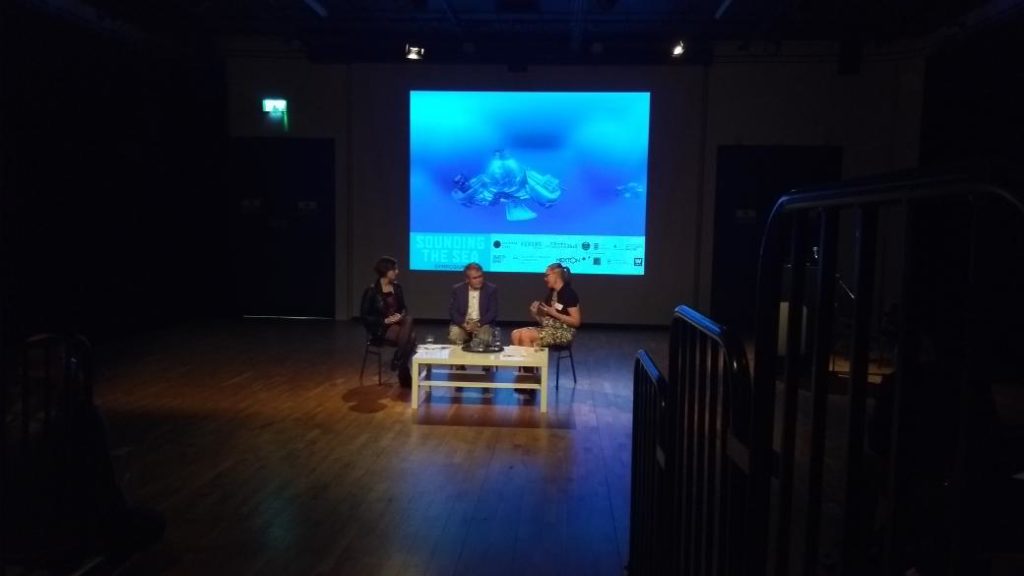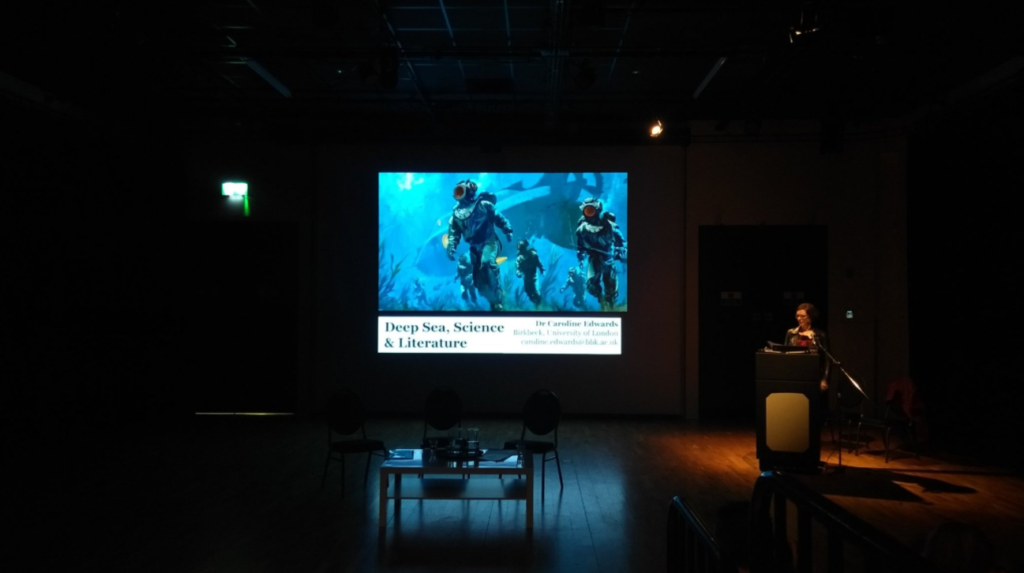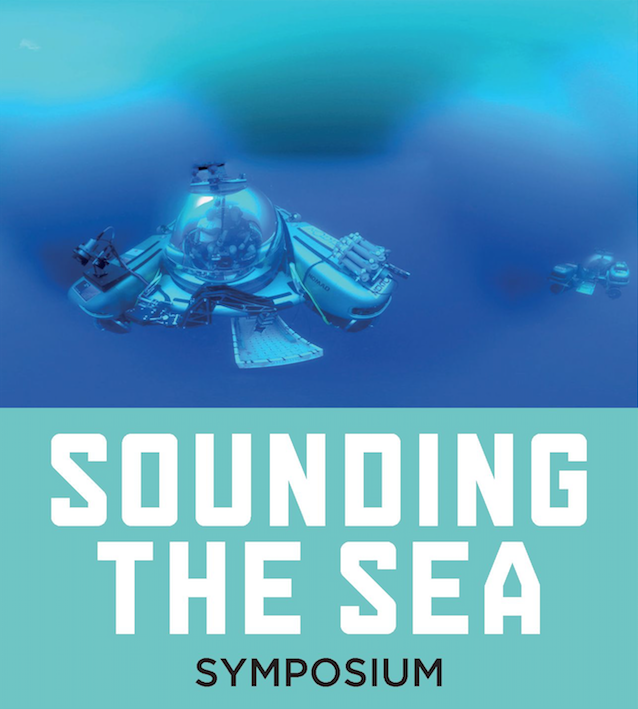Hull City of Culture
Following a talk I gave on "The Deep Sea in Science Fiction" at the Wellcome Trust in 2015, as part of the "Incredible Encounters with Light" exhibition, I was delighted to be invited by Invisible Dust to give a follow-up talk as part of the Sounding the Sea two-day symposium. The symposium accompanied the exhibition "Offshore: Artists Explore the Sea" being held at the Ferens Art Gallery and Hull Maritime Museum from 1 April – 28 August 2017, which is taking place as part of Hull UK City of Culture 2017.
Sounding The Sea brought together scientists, artists and writers to explore and celebrate our cultural, historical and scientific connection to the ocean and included talks by authors China Miéville and Philip Hoare, artists Bik Van der Pol and Mariele Neudecker, producer of new film Plastic Oceans Jo Ruxton, marine biologists and ocean campaigners such as Professor Alex Rogers (University of Oxford) and Dr Magnus Johnson (University of Hull) as well as many others speakers. Topics such as climate change, rising sea levels, marine life, and our cultural ties to the sea were discussed through talks and discussion panels, participatory workshops, artist performances and film screenings. My talk on science fiction and the deep sea formed part of the first day's keynote along with Professor Alex Rogers (Oxford University), whose work in ecology, conservation and the evolution of marine species has informed policy at the UN International Seabed Authority, UN Division of Oceans and Law of the Sea, as well as supported NGOs including the WWF, Greenpeace and the Deep-Sea Conservation Coalition. Our session also included a discussion with China Miéville (whose work I have published on in my co-edited essay collection China Miéville: Critical Essays, 2015) who read from a short story that was specially commissioned for the exhibition, titled "Tehom." The story was inspired by Miéville's trip to Bermuda to follow in the footsteps of American naturalist William Beebe (who had travelled there eight decades earlier) to descend into the sea in a submersible; and underwater footage from this descent is also available to watch in the Hull Maritime Museum as part of the Offshore exhibition.
My talk was titled "The Deep Sea, Science and Literature" and considered literature's relationship with the sea, its merchants, sailors, adventures and dangers since modernity and into the contemporary period. Early eighteenth-century novels such as Daniel Defoe's Robinson Crusoe (1719) and Jonathan Swift's Gulliver's Travels (1726) often featured sea voyages and adventure. As the scholar Margaret Cohen has argued, these seafaring protagonists illustrated the exercise of practical reason in the age of scientific enlightenment, focusing upon the characters' individualism, “embodied intelligence” and ability to negotiate rapidly changing situations at sea. “The mariner’s glamour," Cohen writes, "was inseparable from the prominence of the oceans across this span as one of modernity’s most dynamic, productive frontiers” (Cohen 2). Whilst narratives about mariners and seafaring voyages reflected upon the cutting edge technology of the day, including global communications, the transportation of commodities, and the transference and accumulation of wealth (particularly towards the European colonizing nations), literature also became increasingly preoccupied in the mid- to late nineteenth century with examining the deep sea as an unknowable space: sinister, ancient, and out of the reach of scientific or rational scrutiny. In novels such as In Search of the Castaways (1867-8), Twenty Thousand Leagues Under the Sea (1870), The Mysterious Island (1874), The Sea Serpent (1901) and Invasion of the Sea (1905), French author Jules Verne popularised scientific and marine expeditions into what he calls in Twenty Thousand Leagues “this mysterious sea, whose great depths had up to this time been inaccessible to the eye of man” (Verne 14).
A decade after Verne's death, American writer H. P. Lovecraft similarly mined the deep sea as the habitat for his disturbing, Weird cosmology – as exemplified in the figure of Cthulhu first introduced in his short story "The Call of Cthulhu" published in Weird Tales in 1928. Similarly, in the short story “Dagon,” first published in The Vagrant in 1919, Lovecraft describes a Sumerian fish god that leads an prehuman amphibious race that strikes terror into the sailors that witness it. As the first-person narrator writes: “I cannot think of the deep sea without shuddering at the nameless things that may at this very moment be crawling and floundering on its slimy bed, worshipping their ancient stone idols and carving their own detestable likenesses on submarine obelisks of water-soaked granite. I dream of a day when they may rise above the billows to drag down in their reeking talons the remnants of puny, war-exhausted mankind – of a day when the land shall sink, and the dark ocean floor shall ascend amidst universal pandemonium” (27).
The terror of Lovecraft's insistence upon a time before humanity that threatens to return at any moment and annihilate us, catalysed by a hideous underwater creature from the oceanic depths, can be read comparatively with John Wyndham's 1953 novel The Kraken Wakes, which uses the deep sea to stage an apocalyptic alien invasion inspired by H. G. Wells’ The War of the Worlds (1898). As with his other disaster novels of the 1950s and early ’60s – The Day of the Triffids (1951) and The Chrysalids (1955) – Wyndham is particularly interested in the monsters that might still be possible in a scientific, rationalized and technologically advanced world; where other SF writers of this period are more interested in speculative technologies, future intergalactic societies and alien civilizations. The deep sea is described in The Kraken Wakes as “the most secret womb in the world” (71). At the Cayman Trench (between Jamaica and Cuba), some 5.5 miles deep, the British send divers with a bathysphere, a deep-sea submersible lowered into the ocean by a cable, into the oceanic depths to investigate: “Again we watched the descent through the ocean layers, but this time instead of a commentary we had an astonishing assortment of chirrupings, raspings, and gruntings picked up by externally mounted microphones. The deep sea is, in its lower inhabited strata, it seems, a place of hideous cacophony” (34). And as the camera display returning images from the Cayman Trench reveals, the deep sea appears “always tantalizingly ill-defined, and never quite well enough illuminated for one to be quite certain even of its shape” (34) – the perfect place in which to imagine all kinds of non-human and alien threats, from the supernatural, the prehistoric (following its own alternative evolutionary line) to the technologically superior alien race.
More recently, as our own apocalyptic imaginary has moved ever further into the realms of ecocatastrophe (rather than nuclear disaster), a number of recent speculative and science fiction novels have dealt with the deep sea in a different way – through stories of global warming, rising sea levels, and flooding on a planetary scale. Nnedi Okorafor’s 2014 novel Lagoon is a good example of a contemporary narrative that reimagines Wells’ alien invasion in The War of the Worlds, but set in Lagos, Nigeria. Here the deep sea harbors sentient creatures who are afforded their own narrative voice through the use of non-human point of view chapters, such as the swordfish: “She is the largest predator in these waters. Her waters. Even when she migrates, this particular place remains hers. Everyone knows it” (3). Meanwhile, novels such as Maggie Gee’s The Flood (2004), David Maine’s literal journey to Ararat in his retelling of Noah’s Ark, also titled The Flood (2004), Marie NDiaye’s genre-melding memoir, Autoportrait en vert [Self-Portrait in Green] (2005), Margaret Atwood’s The Year of the Flood (2009), and the postdiluvian archipelago of 26th-century Ing in Will Self’s, The Book of Dave (2006), all present postdiluvian narrative worlds in which islands replace former nations, countries and continents. And yet, curiously, whether set in the satirical consumerist present-day Londons (Gee, Self or Lloyd), or envisioning more dreamlike literary worlds (Maine, Martel or NDiaye, these texts suggest our ongoing fascination with the deep sea and its narrative possibilities.
Click here to view the programme from the Sounding the Sea symposium.
See below for some photographs from my talk and the keynote discussion with curator Alice Sharp (Invisible Dust) and Prof. Alex Rogers.
 |
 |
For more photographs from Sounding the Sea, see the twitter hashtag #SoundingtheSea17.







 Dr Caroline Edwards is Senior Lecturer in Modern & Contemporary Literature at Birkbeck, University of London. Her research and teaching specialisms are in 21st century literature and critical theory, science fiction and post-apocalyptic narratives, Marxist aesthetics, and utopianism.
Dr Caroline Edwards is Senior Lecturer in Modern & Contemporary Literature at Birkbeck, University of London. Her research and teaching specialisms are in 21st century literature and critical theory, science fiction and post-apocalyptic narratives, Marxist aesthetics, and utopianism.
Follow / Contact